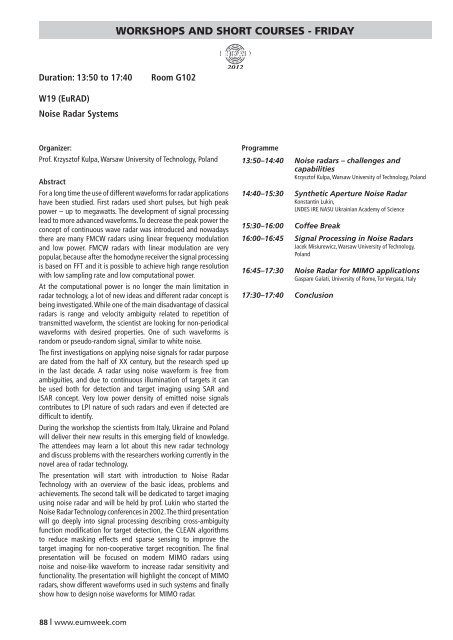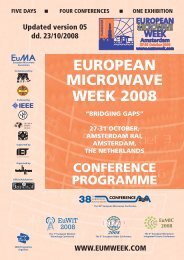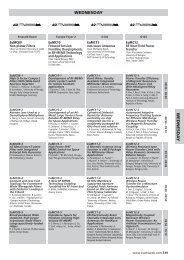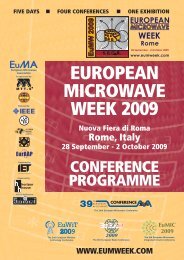FRIDAY - European Microwave Week
FRIDAY - European Microwave Week
FRIDAY - European Microwave Week
You also want an ePaper? Increase the reach of your titles
YUMPU automatically turns print PDFs into web optimized ePapers that Google loves.
Duration: 13:50 to 17:40 Room G102<br />
W19 (EuRAD)<br />
Noise Radar Systems<br />
Organizer:<br />
Prof. Krzysztof Kulpa, Warsaw University of Technology, Poland<br />
Abstract<br />
For a long time the use of different waveforms for radar applications<br />
have been studied. First radars used short pulses, but high peak<br />
power – up to megawatts. The development of signal processing<br />
lead to more advanced waveforms. To decrease the peak power the<br />
concept of continuous wave radar was introduced and nowadays<br />
there are many FMCW radars using linear frequency modulation<br />
and low power. FMCW radars with linear modulation are very<br />
popular, because after the homodyne receiver the signal processing<br />
is based on FFT and it is possible to achieve high range resolution<br />
with low sampling rate and low computational power.<br />
At the computational power is no longer the main limitation in<br />
radar technology, a lot of new ideas and different radar concept is<br />
being investigated. While one of the main disadvantage of classical<br />
radars is range and velocity ambiguity related to repetition of<br />
transmitted waveform, the scientist are looking for non-periodical<br />
waveforms with desired properties. One of such waveforms is<br />
random or pseudo-random signal, similar to white noise.<br />
The first investigations on applying noise signals for radar purpose<br />
are dated from the half of XX century, but the research sped up<br />
in the last decade. A radar using noise waveform is free from<br />
ambiguities, and due to continuous illumination of targets it can<br />
be used both for detection and target imaging using SAR and<br />
ISAR concept. Very low power density of emitted noise signals<br />
contributes to LPI nature of such radars and even if detected are<br />
difficult to identify.<br />
During the workshop the scientists from Italy, Ukraine and Poland<br />
will deliver their new results in this emerging field of knowledge.<br />
The attendees may learn a lot about this new radar technology<br />
and discuss problems with the researchers working currently in the<br />
novel area of radar technology.<br />
The presentation will start with introduction to Noise Radar<br />
Technology with an overview of the basic ideas, problems and<br />
achievements. The second talk will be dedicated to target imaging<br />
using noise radar and will be held by prof. Lukin who started the<br />
Noise Radar Technology conferences in 2002. The third presentation<br />
will go deeply into signal processing describing cross-ambiguity<br />
function modification for target detection, the CLEAN algorithms<br />
to reduce masking effects end sparse sensing to improve the<br />
target imaging for non-cooperative target recognition. The final<br />
presentation will be focused on modern MIMO radars using<br />
noise and noise-like waveform to increase radar sensitivity and<br />
functionality. The presentation will highlight the concept of MIMO<br />
radars, show different waveforms used in such systems and finally<br />
show how to design noise waveforms for MIMO radar.<br />
88<br />
www.eumweek.com<br />
WORKSHOPS AND SHORT COURSES - <strong>FRIDAY</strong><br />
Programme<br />
13:50–14:40 Noise radars – challenges and<br />
capabilities<br />
Krzysztof Kulpa, Warsaw University of Technology, Poland<br />
14:40–15:30 Synthetic Aperture Noise Radar<br />
Konstantin Lukin,<br />
LNDES IRE NASU Ukrainian Academy of Science<br />
15:30–16:00 Coffee Break<br />
16:00–16:45 Signal Processing in Noise Radars<br />
Jacek Misiurewicz, Warsaw University of Technology,<br />
Poland<br />
16:45–17:30 Noise Radar for MIMO applications<br />
Gaspare Galati, University of Rome, Tor Vergata, Italy<br />
17:30–17:40 Conclusion








